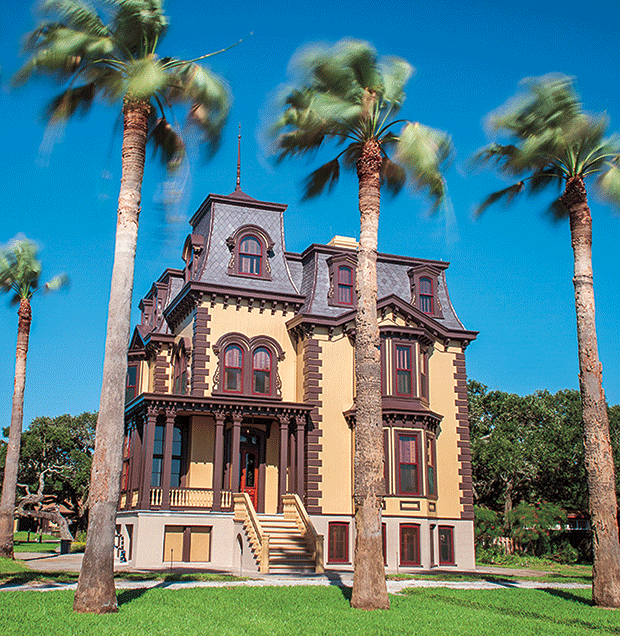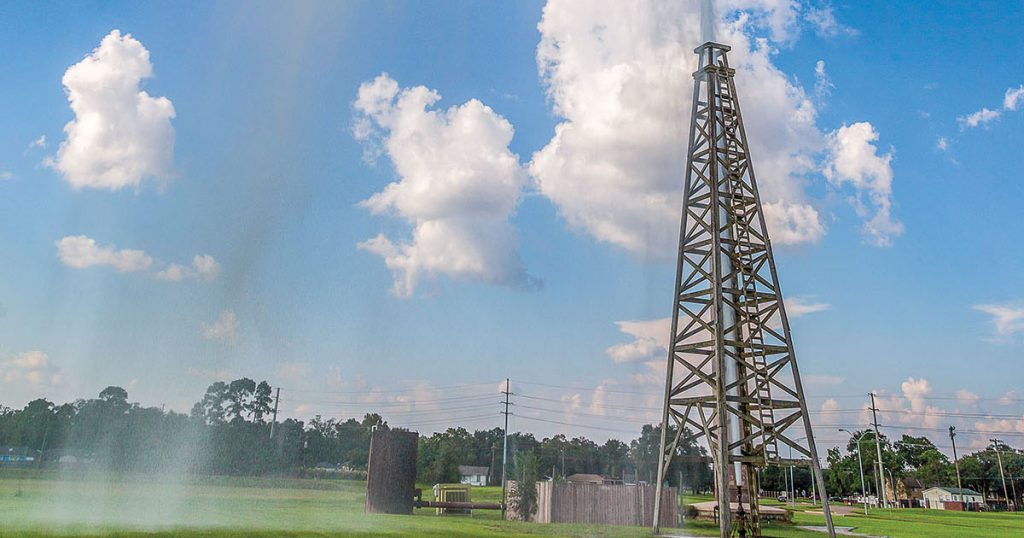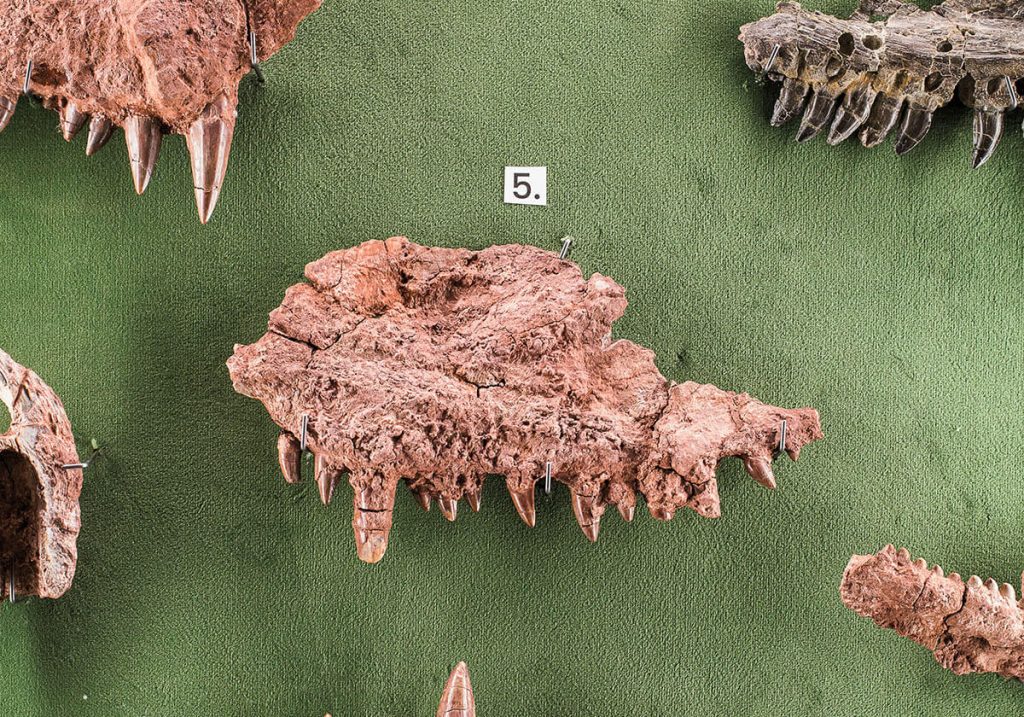
It’s safe to say that an elegant, 19th-Century mansion was not what I was expecting to see as I drove down a breezy bay-front road in Rockport. But there it was, on the same street as low-slung souvenir shops, seafood restaurants, and coastal cottage homes: a four-story, Victorian structure with sand-colored walls, dark mocha trim, and a steep mansard roof. The grand edifice looked a bit out of place among the swaying palm trees and coastal live oaks along Fulton Beach Road.
The Fulton Mansion State Historic Site, at 317 Fulton Beach Rd. in Rockport, opens Tue-Sat 9:30-4:30 and Sun 12:30-4:30. Tickets cost $6 for adults and $4 for ages 6-18. Call 361/729-0386.
And yet, the regal abode of George Fulton, a 19th-Century cattleman, sits no more than a few dozen yards from Aransas Bay’s breaking surf, just as it has since 1877. Now open to visitors as the Fulton Mansion State Historic Site, the structure has always stood out. “It was the grandest house around, all by design,” Site Manager Marsha Hendrix says. “It’s a tall, narrow house that you would see on a narrow city lot, and the Victorian style, which is specifically the French Second Empire style, was probably something the family had seen in Cincinnati or Baltimore or another big city.”
The 6,200-square-foot mansion is a well-preserved example of how the well-heeled lived in the late 1800s, but such preservation comes with a price. The Texas Historical Commission recently completed a three-year, $3.1 million restoration project, during which the house was closed to the public. It re-opened last October for guided and individual tours with expanded exhibits about the people who made this home more than just an architectural gem.
On arrival, it’s tempting to head straight for the house, but visitors are encouraged to begin in the Education and History Center, located next door on the site’s three-and-a-half-acre grounds. The center’s exhibits provide historical context about George Fulton, a Philadelphia-born engineer and businessman who came to join the rebels in the Texas Revolution but arrived after the war was won. He enlisted in the Republic of Texas Army, earned a land grant in San Patricio County, worked for the General Land Office, and married Harriet Smith, the daughter of Henry Smith, an early 1830s Texas politician and independence advocate with land holdings in Brazoria and Aransas counties. The newlyweds soon followed job opportunities out of state as George worked for a Baltimore newspaper and for railroad companies in the Midwest and on the East Coast. When the couple inherited Henry Smith’s land on Live Oak Peninsula and returned to Texas in 1867, they had no intention of giving up the luxuries they had grown accustomed to.
The Fultons chose Rockport to settle and launch a cattle company, eventually operating the country’s first refrigerated slaughterhouse. Inside the mansion, which the family named Oakhurst, visitors can see what kind
of lifestyle cattle money could buy in those days.
The mansion features indoor plumbing with flush toilets and hot and cold running water, and central heat—all firsts for the area—as well as tasteful applications of Harriet’s fondness for urbane, East Coast-influenced décor. Examples include the New York-made crystal chandelier hanging in the vestibule, the wall-to-wall carpet throughout the house, and the rose-band patterned china in the dining room. Beautiful woodwork, like red cypress pocket doors with black walnut trim and longleaf pine flooring, along with nine ornate faux fireplaces, provide a warm, cozy feeling. The furnishings on display in the house today are a mix of original pieces and period antiques.
I especially enjoy George’s library. Since his main job was lining up financing for the Coleman-Fulton Pasture Company, he regularly wined and dined investors before bringing them to the library to close the deal. It’s easy to imagine him and a fellow businessman leaned over the chessboard, enjoying glasses of beer and making highly motivated calculations about the game
and otherwise.
“The chess table and pieces actually belonged to George,” Hendrix says, adding that other family belongings, like Harriet’s music box in the sitting room, have found their way back to the historic site by donations from relatives.
For nearly 140 years, the Fulton Mansion endured hurricane winds, storm surges, and high humidity, not to mention a fast-moving army of hungry Formosan termites in 2006. When it closed in February 2013 for the renovation, there were serious issues to address, from the leaky basement foundation to the leaky bay windows and slate roof. A project scheduled to last one year grew into two years and eight months.
During the closure, Hendrix and her coworkers organized new exhibits with never-before-heard stories that focus on, of all places, the basement. They mined census records, the payroll, letters, and shopping lists to find out more about the people working behind the scenes—the cooks, housekeepers, gardeners, maids, and footmen.
The Fultons’ servants spent much of their time working in the basement, the location of the kitchen, laundry, heating, and water systems. These workers often endured an inch or two of standing water in the basement. “It was a really bad idea to have a basement in this house,” says Hendrix, indicating the nearby waters of Aransas Bay. “The water continues to seep in to this day, and several sump pumps have been installed. George should have known better, but he was from Philadelphia and he was determined to have a basement.”
The basement had walls and floors made of shellcrete, a mix of local sand and crushed oyster shells, and a larder kept cool by a wrap-around, ice-water-filled trough. Exhibits in the basement explain how workers stoked the furnace continuously with wood and coal to produce heat, and laundry took two days to complete. But the basement was not as dark and dreary as it could have been. Most of the basement stands above ground, and windows let in sunshine.
D.J. Chilcoat, a volunteer docent, said that as much as visitors love seeing the mansion’s beautiful upstairs floors, the new basement exhibits truly bring the time period to life. “This has been a new way for the Fultons to become very real to them,” she says. “Hearing how Harriet’s chef, Bony [Bonaparte Chandler], created not-to-be-missed dinner par-ties from the basement—oh, my—sometimes it’s hard to coax people out of the basement for the rest of the tour.”
As far as basements go, it’s unexpectedly cozy, which shouldn’t be all that surprising. From the first time I laid eyes on the Fulton Mansion, it has surpassed my expectations.








